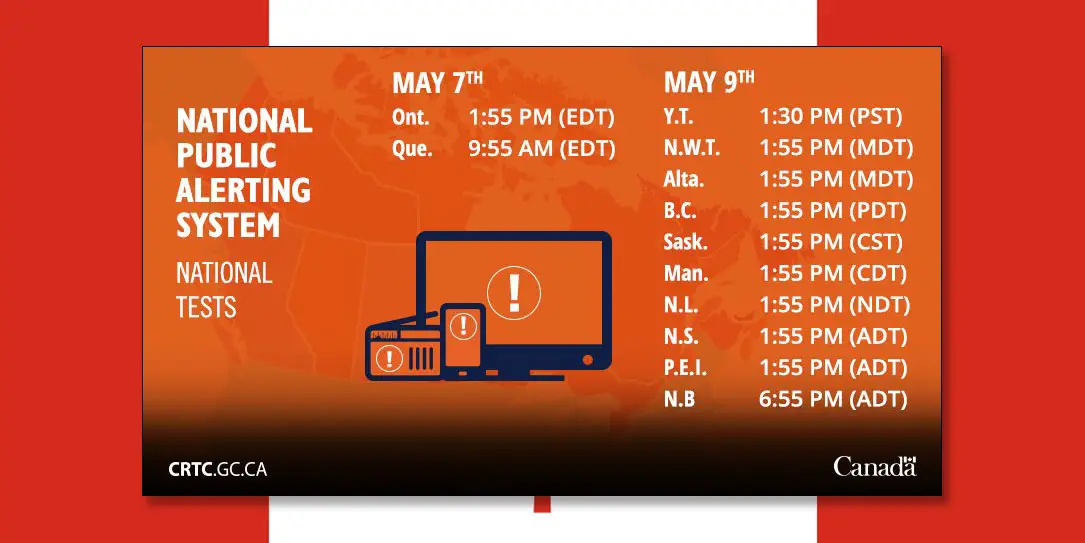While many jurisdictions have a public alerting system, Canada is somewhat behind the times when it comes to a nationwide mobile alert system. That’s about to change as the CRTC (Canadian Radio-television and Telecommunications Commission) is testing their updated system this week at various times across the country. While the CRTC does have an alert system, in the past it has been limited to TV and radio broadcasts and consists of an alert tone followed by an emergency message.
NOTICE
🚨 PUBLIC ALERTING TESTS on compatible LTE-connected #wireless devices, television and radio.Dates:
May 7: Ontario and Quebec.
May 9: Y.T, B.C, Alta., N.W.T., Sask., Man., N.B, N.S, P-E-I, N.L. https://t.co/XfXVpYoCkT pic.twitter.com/i3UoXkx6bF— CRTCeng (@CRTCeng) May 3, 2018
As seen in the tweet above, the tests will be conducted across the country at various times:
- May 7th
- Ontario 1:55 PM (EDT)
- Quebec 9:55 AM (EDT)
- May 9th
- Yukon 1:30 PM (PST)
- Northwest Territories 1:55 PM (MDT)
- Alberta 1:55 PM (MDT)
- British-Colombia 1:55 PM (PDT)
- Saskatchewan 1:55 PM (CST)
- Manitoba 1:55 PM (CDT)
- Newfoundland & Labrador 1:55 PM (NDT)
- Nova Scotia 1:55 PM (ADT)
- Prince Edward Island 1:55 PM (ADT)
- New-Brunswick 6:55 PM (ADT)
If you’re on one of the providers listed below and have an LTE mobile device connected to an LTE cellular network when the test goes off in your area, you should get a test emergency alert on your device. The tests will be conducted each May during the government’s Emergency Preparedness Week.
- 2251723 Ontario
- Access
- AEBC Internet
- Bell
- Bell ExpressVu
- Bragg Communications Incorporated
- Câblevision du Nord de Québec
- Cogeco Connexion Inc.
- IAAK Technologies
- K-Right Communications
- Nexicom Communications
- Northwestel
- Persona Communications
- Rogers
- SaskTel
- Shaw
- Shaw Direct
- Sogetel
- TBayTel
- TELUS
- Vianet
- Vidéotron
- Wightman Telecom
- Zazeen
The alert will consist of the same alert tone that is currently used on the TV and radio alerts with a unique vibration on your smartphone or other LTE connected device. A Cell Broadcast message which resembles a text message will also appear on your device.
Emergency alerts are issued to a defined geographic area, such that only people in the defined area will receive the emergency alerts. If you are travelling in another province when an alert is issued, your compatible wireless device will receive the alert, provided your phone is powered on and connected to the LTE cellular network. There is no need to enable the location services on your wireless device to receive alerts.
Emergency alerts can be sent out in case of fire, natural disasters, biological, hazardous, environmental, terrorist, or civil threats. These can cover everything from wildfires to drinking water contamination to Amber Alerts and everything in between, including the occasional test alert. You can check the Alert Ready website for a further list of types of alerts that will be broadcast over the new system.
The CRTC has also set up a pretty robust process which includes the government, the NAAD (National Alert Aggregation and Dissemination) System and alert distributors to ensure that only valid and actual emergency alerts are sent out. Hopefully, it’s robust enough to prevent false alerts like the one that went out in Hawaii last year causing widespread panic.
What do you think about Canada’s new Alert Ready system? Let us know in the comments below or on Google+, Twitter, or Facebook.
[button link=”https://crtc.gc.ca/eng/television/services/alert.htm” icon=”fa-external-link” side=”left” target=”blank” color=”285b5e” textcolor=”ffffff”]Source: CRTC[/button][button link=”https://www.alertready.ca/” icon=”fa-external-link” side=”left” target=”blank” color=”285b5e” textcolor=”ffffff”]Source: Alert Ready[/button]









